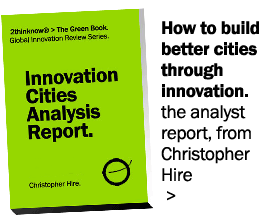 RANK CITY STATE COUNTRY REGION 2010 GRADE
RANK CITY STATE COUNTRY REGION 2010 GRADE
1 Boston Massachusetts United States AMERICAS 1 NEXUS
2 Paris France EUROPE 1 NEXUS
3 Amsterdam Netherlands EUROPE 1 NEXUS
4 Vienna Austria EUROPE 1 NEXUS
5 New York New York United States AMERICAS 1 NEXUS
6 Frankfurt Germany EUROPE 1 NEXUS
7 San Francisco California United States AMERICAS 1 NEXUS
innovation DAILY
Here we highlight selected innovation related articles from around the world on a daily basis. These articles related to innovation and funding for innovative companies, and best practices for innovation based economic development.
Are Two Heads Better Than One? It Depends
 From coalition governments to teams of scientists, the notion that “two heads are better than one” is the en vogue approach to problem-solving these days.
From coalition governments to teams of scientists, the notion that “two heads are better than one” is the en vogue approach to problem-solving these days.
The premise is simple: We perform better and make more sensible
decisions by putting our heads together than by working alone. For
example, let’s say that there are two stock traders – Warren and Ben.
The notion is that if they work together to pick stocks they will make
more profit than if they work in isolation.
Light Diet: Eating Food without Seeing It May Impede Ability to Judge Hunger
 As psychologist Benjamin Scheibehenne
and his wife left the restaurant where they had just finished dinner,
they discussed whether to stop somewhere else for dessert. It was an
everyday decision, one they had made countless times before, but this
particular evening they could not make up their minds.
As psychologist Benjamin Scheibehenne
and his wife left the restaurant where they had just finished dinner,
they discussed whether to stop somewhere else for dessert. It was an
everyday decision, one they had made countless times before, but this
particular evening they could not make up their minds.
"When we came out of the restaurant, we didn't really know whether we were still hungry or not," Scheibehenne recalls. "We realized we were completely clueless about how much we actually consumed."
Realities of VC Investment in Water Tech
 Water is an enormous issue around the globe -- for drinking, farming and industry.
Water is an enormous issue around the globe -- for drinking, farming and industry.
There is a looming water crisis facing everyone on Earth as
populations rise, pollution increases and climate and weather patterns
change. There is already a water crisis in many developing nations and
in some not-so-developing regions, like Australia and California. The
stats for "embedded" or "virtual" water are sobering -- for example, the
production of 1 kilogram of beef requires the use of 15,500 liters of
water (see WaterFootprint.org).
And
water is inextricably linked to energy -- California uses an
extraordinary amount of power to move water around the state. In fact, a
fifth of the electricity used in California is intertwined with water.
So is 30 percent of the natural gas, according to the California Energy
Commission. Most of that power is actually used to heat water for hot
showers and clean hospital equipment, but around five percent to six
percent of all of California's energy gets consumed simply by moving
water.
A Proposal of Indicators and Policy Framework for Innovation Benchmark in Europe
 The implementation of innovation policies has been adopted at European level from a common perspective. The European Council (2000) established open methods of coordination (OMC) in order to gain mutual understanding and achieving greater convergence on innovation policies, constituting a benchmarking procedure. However, the development of benchmarking analysis for innovation policies faces two major inconveniences: the lack of accepted innovation policy frameworks and the existence of suitable indicators to measure their performance.
The implementation of innovation policies has been adopted at European level from a common perspective. The European Council (2000) established open methods of coordination (OMC) in order to gain mutual understanding and achieving greater convergence on innovation policies, constituting a benchmarking procedure. However, the development of benchmarking analysis for innovation policies faces two major inconveniences: the lack of accepted innovation policy frameworks and the existence of suitable indicators to measure their performance.
This article has a twofold objective: on the one hand, conducting an analysis of the existing innovation policy frameworks, putting forward a set of innovation policies which could be used as reference for policy analysis and on the other hand, proposing a set of indicators for measuring their performance.
Download the PDF
The top ten best cities for the next ten years
 “We live in challenging times. Unemployment remains high, and the U.S. lead in technology and science is slipping as many foreign countries gain ground. But some U.S. cities, though slowed by the Great Recession, still thrive by lifting good old American innovation to new levels. And that will help put more Americans back to work and keep our international
“We live in challenging times. Unemployment remains high, and the U.S. lead in technology and science is slipping as many foreign countries gain ground. But some U.S. cities, though slowed by the Great Recession, still thrive by lifting good old American innovation to new levels. And that will help put more Americans back to work and keep our international
edge,” says the staff at Kiplinger who recently named the top 10 best cities for the next ten years.
With news of Austin being in the top spot, broker Krisstina Wise of The Goodlife Team said, “Austin is the place to be. First of all, unemployment in Austin is 6.8% compared to 9.8% nationally. Austin has been recognized on many top 10 lists including very recently: #1 of top 10 best cities for the next decade, #1 state for business, [and] Williamson Country [is] one of the fast growing counties in the US. And, Austin is simply a great place to live–a good life/work balance focused on health and family while being socially liberal in nature. Austinites embrace & inspire entrepreneurialism and supports local business– while housing, relative to the superior lifestyle, is very affordable. Austin is definitely the place to be for the next decade.”
All states not created equal when it comes to energy efficiency, but they can be
 There’s a new report out from the Center for American Progress and Energy Resource Management (EnergyRM)
that takes a stab at listing the top states when it comes to policy
leadership on energy efficiency. The big push by the report’s
co-authors, who include the Senate Majority Leader Harry Reid, is that
the United States should treat the idea of energy efficiency as another
potential source of power generation.
There’s a new report out from the Center for American Progress and Energy Resource Management (EnergyRM)
that takes a stab at listing the top states when it comes to policy
leadership on energy efficiency. The big push by the report’s
co-authors, who include the Senate Majority Leader Harry Reid, is that
the United States should treat the idea of energy efficiency as another
potential source of power generation.
“Energy efficiency IS energy,” says Bill Campbell, the chair of Energy Resource Management and another report co-author.
The report is being released to help encourage the development of what Reid calls “compact” legislation to help drive energy efficiency efforts across the United States. Since other legislation intended to help American’s innovation in renewable energy keeps getting stalled by old-school political agendas and a lack of bipartisan support, Reid figures that focusing on initiatives that can produce results more quickly might be more fruitful.
The Bootstrapping Secrets of Great Entrepreneurs You’ve Never Heard Of
 Probably too much ink is spilled over VC funded companies. It’s curious… given that these companies represent such a small minority of the entrepreneurial activity in this country.
Probably too much ink is spilled over VC funded companies. It’s curious… given that these companies represent such a small minority of the entrepreneurial activity in this country.
Perhaps it’s because the stories of ambitious entrepreneurs pitching their dream to mysterious VC’s make for good, sexy fodder.
It’s great to celebrate startups, but the imbalance of press received by VC backed companies misguides some first-time entrepreneurs into thinking that the only path to success is through institutional funding.
9 Ways To Work Less And Do More
 The universal challenge of every startup founder is to get everything done that needs to get done, and still have a life.
The universal challenge of every startup founder is to get everything done that needs to get done, and still have a life.
Even outside of business, everyone wants to accomplish more, while working less. I’ve been a student of these techniques for some time, but recently I saw a great summary that seems to pull all the key principles together.
Steve Robbins, known on the Internet as the Get-It-Done Guy, just published his book “9 Steps to Work Less and Do More,” which outlines his strategies. These are not aimed specifically at entrepreneurs, but certainly can be applied there as follows:
10 Tips To Take Control Of Your Inbox
 Email is a major time-suck for people in most workplaces, whether they realize it or not.
Email is a major time-suck for people in most workplaces, whether they realize it or not.
Mark Suster recently declared that email is toxic. And it's not hard to see why: our inboxes have become a suffocating reservoir of debris and to-do’s, when they’re really meant to be a tool for communication and better productivity.
“Email is killing companies,” Cameron Herold, CEO coach and founder of BackPocket COO, says adamantly.
When should a start-up consider going global, and what are the biggest challenges in doing so?
 Video: Should a Start-up Focus on Going Global Right Away?
Video: Should a Start-up Focus on Going Global Right Away?
Randy Komisar, Kleiner Perkins Caufield & Byers - 3 min. 19 sec.
According to Komisar, globalization needs to be part of the tool set for every entrepreneur doing a start-up today. This doesn't mean immediately going global, but understanding the global market and having a plan for the future, he adds. Video: Globalization: Acting Local to be Global
Video: Globalization: Acting Local to be Global
Janice Roberts, Mayfield Fund - 3 min. 42 sec.
Mayfield Fund, a venture capital firm based in Silicon Valley, expands its operations in China and India to locally participate in the companies it funds. Roberts notes that this enables Mayfield Fund to understand the unique opportunities offered by different geographic locations. Video: Challenges of a Global Company
Video: Challenges of a Global Company
Scott Kriens, Juniper Networks - 3 min. 13 sec.
One of Juniper Networks's biggest challenges is efficiently operating a global company. CEO Scott Kriens challenges the audience to obtain the skill set necessary to work in a global team environment.  Video: Entering a Global Market
Video: Entering a Global Market
Gil Penchina, Wikia - 4 min. 36 sec.
Wikia CEO Gil Penchina discusses the steps that entrepreneurs should take when entering a new and unfamiliar global market.
Why Do So Many Women-Owned Businesses Struggle to Make It to $1 Million?
 Bloomberg Businessweek
recently featured a fascinating interview with Nell Merlino, the
founder of Make Mine a Million. The program, which Merlino founded in
2005, had a goal of helping 1 million women-owned businesses reach 1
million in sales by 2010.
Bloomberg Businessweek
recently featured a fascinating interview with Nell Merlino, the
founder of Make Mine a Million. The program, which Merlino founded in
2005, had a goal of helping 1 million women-owned businesses reach 1
million in sales by 2010.
Merlino didn’t achieve that goal, but she’s looking at the positive side: “We’ve raised $10 million and helped women generate $100 million in revenue and create 6,000 jobs.”
Doctors Seek Way to Treat Muscle Loss
 Bears emerge from months of hibernation with their muscles largely intact. Not so for people, who, if bedridden that long, would lose so much muscle they would have trouble standing.
Bears emerge from months of hibernation with their muscles largely intact. Not so for people, who, if bedridden that long, would lose so much muscle they would have trouble standing.
Why muscles wither with age is captivating a growing number of scientists, drug and food companies, let alone aging baby boomers who, despite having spent years sweating in the gym, are confronting the body’s natural loss of muscle tone over time.
Comparisons between age groups underline the muscle disparity: An 80-year-old might have 30 percent less muscle mass than a 20-year-old. And strength declines even more than mass. Weight-lifting records for 60-year-old men are 30 percent lower than for 30-year-olds; for women the drop-off is 50 percent.
Four Ways We Kill Innovation
 Harvard Business Review had a great post last week entitled “5 Warning Signs That Your Innovation Efforts are Going Off the Rails.”
Harvard Business Review had a great post last week entitled “5 Warning Signs That Your Innovation Efforts are Going Off the Rails.”
I had to chuckle as I read the post – focused on how to make innovation efforts a partnership with the core business focus, instead of a competition. I didn’t chuckle because it was amusing. I chuckled because I’ve seen all five ‘warning signs’ touted as the foundations of the innovation effort, not as unwanted by-products. We’re often proud to be operating in a way that produces just these signs. How wrong is that?
Based on a number of status quo approaches, we set up innovation as a competitor to our current model. It’s time we changed those status quos!
How to Redesign Life
 At the J. Craig Venter Institute in Rockville, MD, researchers have developed one of the most powerful methods yet for redesigning life. By editing genomes on the computer, synthesizing them in the lab, and transplanting the genomes into cells, Venter Institute researchers can speed up the process of genetic engineering. Ultimately, they want to design and create microbes that efficiently produce clean fuels, vaccines, and other products.
At the J. Craig Venter Institute in Rockville, MD, researchers have developed one of the most powerful methods yet for redesigning life. By editing genomes on the computer, synthesizing them in the lab, and transplanting the genomes into cells, Venter Institute researchers can speed up the process of genetic engineering. Ultimately, they want to design and create microbes that efficiently produce clean fuels, vaccines, and other products.
For India’s next entrepreneurial wave
 When Sir Gordon Wu, chairman of Hopewell Highway Infrastructure, was a student at Princeton in the 1950s, he dreamt of Chinese superhighways, when China was a poor, closed economy. A few decades later, Wu won the contract to build China’s first superhighway between Shenzhen and Guangzhou.
When Sir Gordon Wu, chairman of Hopewell Highway Infrastructure, was a student at Princeton in the 1950s, he dreamt of Chinese superhighways, when China was a poor, closed economy. A few decades later, Wu won the contract to build China’s first superhighway between Shenzhen and Guangzhou.
While he had no financial support, Wu was offered an incentive by the Chinese government — the faster he could complete the highway, the higher his profits would be. Cutting through the bureaucrac
y, bringing in the best of global technology and finance, Wu deputed 30,000 labourers who took only 26 months to finish a 72-mile superhighway that today zips across the fastest growing region in the world.
By doing so, China set in motion a positive precedence of regional economic development of the scale and size, the world had never seen before. Indeed, incentivised growth, supported by proactive tax regimes, can do wonders for a country and its people.
How to Boost Your Creativity
 According to cognitive psychologist Robert J. Sternberg, creativity can be broadly defined as "...the process of producing something that is both original and worthwhile" (2003). Creativity is all about finding new ways of solving problems and approaching situations. This isn't a skill restricted to artists, musicians or writers; it is a useful skill for people from all walks of life. If you've ever wanted to boost your creativity, these tips can help.
According to cognitive psychologist Robert J. Sternberg, creativity can be broadly defined as "...the process of producing something that is both original and worthwhile" (2003). Creativity is all about finding new ways of solving problems and approaching situations. This isn't a skill restricted to artists, musicians or writers; it is a useful skill for people from all walks of life. If you've ever wanted to boost your creativity, these tips can help.
1. Commit Yourself to Developing Your Creativity
The first step is to fully devote yourself to developing your creative abilities. Do not put off your efforts. Set goals, enlist the help of others and put time aside each day to develop your skills.2. Become an Expert
One of the best ways to develop creativity is to become an expert in that area. By having a rich understanding of the topic, you will be better able to think of novel or innovative solutions to problems.3. Reward Your Curiosity
US Economic Risks (Sept 2010): Impact on Investors & Entrepreneurs
This post was originally published in a shorter (more sensible) format in the Wall Street Journal online. If you’re short on time click on the WSJ link and read the 990 word version there. Otherwise, grab a cup ‘o coffee …
One year ago I predicted that in 2010/11 the economy, far from being on the path of permanent recovery was on a temporary resurgence and there was a strong possibility of a “double dip” recession. My advice to entrepreneurs was and is “when the hors d’oeuvres tray is being passed take two” (e.g. raise money now to weather any storms).
New nuclear tech 'could benefit developing countries'
The  world is on the brink of a nuclear power renaissance, and developing countries may also benefit, according to researchers.
world is on the brink of a nuclear power renaissance, and developing countries may also benefit, according to researchers.
In a study published in Science this month (12 August) British researchers outlined a vision for flexible and more user-friendly nuclear technologies, as worries over the climate change, energy supply security, and depletion of fossil fuels, are overturning decades of hesitancy over the safety of nuclear power plants.
Robin Grimes, materials
researchers at Imperial College London and William Nuttall, senior lecturer in technology policy at the University of Cambridge, believe nuclear power will become viable for energy production in developing countries post-2030. "Outside currently established nuclear countries, flexible nuclear technologies will be especially attractive, reducing the need for grid infrastructure," Grimes told SciDev.Net.

 A
city does not die when its last resident moves away. Death happens
when municipalities lose the industries and vital populations that made
them important cities.
A
city does not die when its last resident moves away. Death happens
when municipalities lose the industries and vital populations that made
them important cities.

